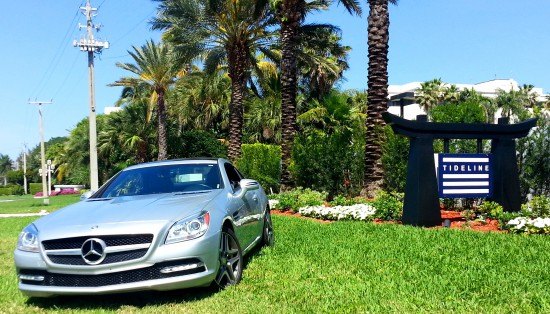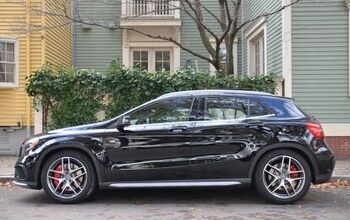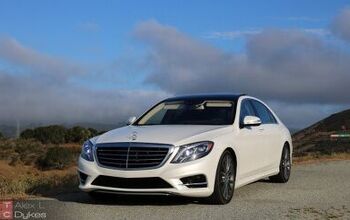Review: 2015 Mercedes SLK250

The idea of the Mercedes SLK is just two years younger than the idea of the Mercedes SL. Of course, back in 1954 the marketing folks didn’t quite have the clout or imagination they have now, so the original SLK was simply called the 190SL. Like today’s SLK, it was based on small-sedan mechanicals and shared very little with the high-end “Gullwing” 300SL. It also outsold its more glamorous relative about eight to one, mostly to the coasts where it served as respectable fair-weather transport for the well-heeled.
The 190SL extracted 104 horsepower from a 1.9-liter four-cylinder engine. Even by the standards of the day, it was all show and no go — but it was handsome enough and it was also very popular with the right kind of people. The 1.8-liter, 201-horsepower junior variant of the SLK is that car’s natural descendant, so when I found myself at loose ends in Palm Beach this past Saturday, it occurred to me that renting one might be just the ticket for the weekend. Although I have extensive wheel time in the previous two generations of the snub-nose convertible Benz, including a self-funded Nurburgring test day in a second-generation SLK200, I had yet to try out the current model. This would be my chance to see if the SLK is still firmly on the “touring” side of the sport/touring continuum.
There are two ways to look at the $50.195 as-tested price of my SLK250, which was distanced from the $44,875 base MSRP by a commendably-optional seven-speed automatic, an 18-inch wheel upgrade, and a Premium Package consisting of heated seats, a Harmon/Kardon sound system, and a few cold-weather options. You could think of it as one of the most expensive four-cylinder cars money can buy, sandwiched between the far more powerful Mustang GT convertible at $41,800 and the far more capable Corvette convertible at $59,000. But to do so is to miss the SLK’s entire reason for being. There are plenty of places in America, such as Palm Beach, where possession of a Mercedes-Benz is a sort of minimum requirement for membership in society. In a world where you can spend thirty-two grand on an Accord and nearly fifty grand on an Accord wearing a “TLX” badge, this SLK250 is a cheap way to get reasonable treatment from the valet.
What you won’t get for that money is a particularly upscale interior. There’s a lot of brushed-aluminum trim, but MB-Tex is the standard seating and unless you want to crack open your wallet for one of the many designo upgrades your passenger is unlikely to be terribly impressed by the available accommodations. Luckily there’s a remarkable amount of space between the doors, particularly compared to the previous generations of the SLK. Another inch or two of legroom wouldn’t go amiss but the standard “Panorama” smoked-glass top has plenty of space overhead for me.
As a vehicle for bopping between hotels and upscale dinner locations, the little Mercedes-Benz is perfectly satisfactory. The top is snug when it’s up and drops in about thirty seconds. When it’s down, cargo space is significantly restricted but there’s enough room for one rollaway bag. If it will fit in the overhead bin of a regional jet, it will fit in the trunk of an SLK. Don’t expect to fit two of them, however. The climate control would suffice for a much larger car, and the “Logic 7” sound system is worth the modest upcharge. It’s loud enough to be heard with the top down on the freeway, so I dialed up the Miami Vice soundtrack on my phone and went for a late-night ride.
Partnered with the standard six-speed manual, this low-pressure turbo is probably just enough motor to push the SLK250 along. With the optional seven-speed, torque-converter automatic, it takes a firm foot to stay ahead of traffic.
Left to its own devices, the transmission starts in second in accordance with time-honored M-B practice. It’s slow to get moving but once you’re on way the shifts are quick and, on the 2-3, accompanied by a very race-y ignition cut-and-pop reminiscent of the current GTI. A button on the console can switch to “manual” control from the wheel-mounted paddles, but the delay between request and shift can be as much as a full second. I didn’t waste much time pretending to shift for myself, even though the SLK’s native algorithms have the gearbox reaching for seventh at speeds as low as thirty miles per hour, where the turbo will cheerfully puff the car along at 900rpm or so.
As you can see, even with the small engine and the upshift-happy transmission, this is no fuel-economy superstar. Some of this has to be due to the abuse to which rental cars are typically put, but even with some deliberate throttle moderation on my part I could only manage to record 23.6mpg over 100 miles of relaxed driving. My Boxster beats that easily with a 3.2-liter, 264-horsepower flat six, and I’m willing to bet that the SLK350, with its 302-horsepower V-6, can beat it as well. Couple that with the unpleasant diesel rattle the direct-injected four emits at idle, and it becomes rather easy to make the case for the 3.5-liter model, even at a nine-thousand-dollar markup. The big-league power would be just the icing on the cake.
Nine years ago, I managed to get this car’s predecessor, a Euro-market, 163-horsepower, auto-transmission, SLK200, around the Nurburgring in 9:19 on my seventh-ever lap. (That’s what they call a bridge-to-gantry time, by the way; it was an open day.) In my opinion, that SLK was a very usable mix of handling and ride quality, better in that respect for nearly every potential customer than what you got with a Boxster or Z4. This current SLK tilts the balance farther in the direction of comfort, perhaps to the car’s detriment. The steering possesses zero feel or feedback, substituting a silken heaviness that probably communicates “sport” very well to the average Escalade owner but doesn’t exactly inspire me to attack an on-ramp. Even significant potholes are swallowed by the supple chassis and the stiff bodyshell, which makes me think that it would be possible to put in a little spring rate and maybe connect the steering to the front wheels a little better. As it is, you won’t want to take this Benz to a racetrack. It’s as biased towards comfort as the current SL has become, and it feels both larger and more inert than any previous SLK.
It’s tempting to become frustrated with the SLK250, because even today Mercedes-Benz knows how to build brilliant sporting automobiles. If you don’t believe me, spend a day with an SLS Black Series and see if you don’t prefer it to nearly everything else for sale at any price. The nice people at M-B know how to make an SLK that stirs the emotions. They just chose not to do it. Instead, for your fifty thousand dollars you get a very faithful tribute to the original 190SL. It’s stylish enough, it’s comfortable enough, and it will get you parked near the front of your hotel even when there’s a Ferrari FF and a Rolls-Royce Ghost in the lot as well. What it isn’t — fast, capable, brilliant to drive — doesn’t matter much to the vast majority of the people who will buy one. Most TTACers would be better-served with the Boxster, even in its current wide-body form, but if you want the same things that the buyers of the original 190SL wanted, this is the only way you’ll get it.

More by Jack Baruth
Latest Car Reviews
Read moreLatest Product Reviews
Read moreRecent Comments
- MRF 95 T-Bird Whenever I travel and I’m in my rental car I first peruse the FM radio to look for interesting programming. It used to be before the past few decades of media consolidation that if you traveled to an area the local radio stations had a distinct sound and flavor. Now it’s the homogenized stuff from the corporate behemoths. Classic rock, modern “bro dude” country, pop hits of today, oldies etc. Much of it tolerable but pedestrian. The college radio stations and NPR affiliates are comfortable standbys. But what struck me recently is how much more religious programming there was on the FM stations, stuff that used to be relegated to the AM band. You have the fire and brimstone preachers, obviously with a far right political bend. Others geared towards the Latin community. Then there is the happy talk “family radio” “Jesus loves you” as well as the ones featuring the insipid contemporary Christian music. Artists such as Michael W. Smith who is one of the most influential artists in the genre. I find myself yelling at the dashboard “Where’s the freakin Staple singers? The Edwin Hawkins singers? Gospel Aretha? Gospel Elvis? Early Sam Cooke? Jesus era Dylan?” When I’m in my own vehicle I stick with the local college radio station that plays a diverse mix of music from Americana to rock and folk. I’ll also listen to Sirius/XM: Deep tracks, Little Steven’s underground as well as Willie’s Roadhouse and Outlaw country.
- The Comedian I owned an assembled-in-Brazil ‘03 Golf GTI from new until ‘09 (traded in on a C30 R-Design).First few years were relatively trouble free, but the last few years are what drove me to buy a scan tool (back when they were expensive) and carry tools and spare parts at all times.Constant electrical problems (sensors & coil packs), ugly shedding “soft” plastic trim, glovebox door fell off, fuel filters oddly lasted only about a year at a time, one-then-the-other window detached from the lift mechanism and crashed inside the door, and the final reason I traded it was the transmission went south.20 years on? This thing should only be owned by someone with good shoes, lots of tools, a lift and a masochistic streak.
- Terry I like the bigger size and hefty weight of the CX90 and I almost never use even the backseat. The average family is less than 4 people.The vehicle crash safety couldn't be better. The only complaints are the clumsy clutch transmission and the turbocharger.
- MaintenanceCosts Plug in iPhone with 200 GB of music, choose the desired genre playlist, and hit shuffle.
- MaintenanceCosts Golf with a good body and a dying engine. Somewhere out there there is a dubber who desperately wants to swap a junkyard VR6 into this and STANCE BRO it.








































Comments
Join the conversation
Two faux-exhaust tips on the 250-spec? The temerity. The gall. The opprobrium. Last-gen C250's had a caste-appropriate single, poverty-indicative outlet. Sheesh. Reminds me of the transgression Ford committed with the 2011 Mustang hairdresser-spec V6 gaining a second tip. Base engines for the hoi-polloi should always, always, be relegated to hidden vespa-sized, deferentially-downward-angled tips, subdued under the bumper skirt. There ought to be a law (or an executive order, as is the flavour these days).
One of the items that get's lost in comparisons of the "value proposition" of a car like this vs mainstream competition is when you buy a premium brand car, you're not just buying the badge snob factor, but also (typically) premium service from the dealer. The local Lexus dealer will pick up your car and drop off the service laoaner within an 8 mile radius of the dealership. The BMW dealer has a free cafe with food and coffee. The Infiniti dealer used to have a putting green. The Volvo dealer will give you a service loaner if you bought the car from them, whether or not it's under still under warranty. One of our local Fiat dealers (the one I bought my Abarth from) also offers some concierge style services to anyone who buys a car from them. They have complimentary espresso and coffee, lifetime complimentary car washes, complimentary loaner cars, free wifi, and courtesy rides to areas around the dealership. I admit that in one month, I'm already spoiled. People who can afford cars like this are used to similar levels of service in other areas of their life, so they'll probably favor the same sort of experience with their cars. If you don't care about the performance of the car and just want a convertible, wouldn't you rather get Mercedes customer service and amenities vs Ford or Chevrolet?